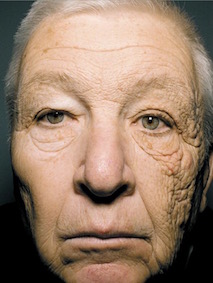Sunscreen.
It’s as simple as that. If you are serious about protecting and preserving your skin, you must apply sunscreen every day. Even when it’s cloudy.
My very first edition of Wellness Words covered the topic of sunscreen. If you read it and were convinced to use sunscreen every day, your skin thanks you.
But if you’re not a convert yet, with a recent streak of sun in London and daylight hours increasing each day, I’d like to advocate again that you add sunscreen to your daily routine.
We are spoiled for choice in how to look after our skin. And while there are many great creams and serums to use, I always tell my clients that the single most important anti-ageing product they should use every morning is sunscreen.
This is because UVA or ageing rays from the sun still reach our skin, no matter what the weather. Consider this photo.
Quite a difference between the two sides of the face, right? Without daily sunscreen application, the right side is significantly more aged thanks to UVA exposure through the window of the lorry (or truck) this man drove for his work.
It can be summed up simply: exposure to UV light is the single biggest cause of ageing to our skin. Sunscreen is the single best way to protect skin from this ageing. I hope you will agree that this picture conveys a thousand words about why daily sunscreen is critical.
If you're not totally convinced or your have more questions, below you’ll find answers to common questions I receive about sunscreen.
Isn’t the SPF in my moisturiser / make-up enough?
In a word, no.
Your sunscreen should be a stand-alone product because sun protection in moisturiser and make-up is generally focused on combating UVB or burning rays in the form of SPF. I have yet to find a non-sunscreen product that offers protection from UVAs. While SPF is important to prevent your skin from burning, it does not protect you from UVAs.
Also, we generally don’t apply enough moisturiser or make-up to give us the proper amount of sunscreen. To get complete ultraviolet light protection, you need a 20 pence (or nickel) size dollop of sunscreen to cover your face, neck and décolleté. Even if you love your moisturiser and wear a full face of make-up, I’m pretty sure, you are not applying that much.
But I look so much better after time in the sun
While it is fashionable, particularly in summer, to have a healthy glow to our skin, consider this. No matter the level of melanin in your skin, when you are exposed to the sun without sunscreen, your melanocyte cells are called upon to defend your skin. These cells produce melanin to stop the UVB rays from penetrating the skin more deeply, causing damage. So your sunkissed tan is in effect a battle scar left after your body had to fight off an invader. Over time, these injuries lead to age spots, pigmentation and sometimes, skin cancer.
Rather than hurting your skin, why not use a self-tanner? I love this duo from Clarins for the face and body. Just a few drops added to moisturiser or oil allow me to build my perfect glow. I also love this booster from Hylamide.
What is the right SPF for me?
When you’re shopping for a sunscreen, you want to find one that contains both SPF (UK and US dermatologists agree that 30 is the ideal level for SPF) and UVA protection.
In Europe, UVA protection is highlighted with the letters UVA in a circle on the label and 0 to 5 stars, ranking its effectiveness.
In the US, sunscreens with UVA and UVB protection are referred to as broad-spectrum, although there is no way to delineate the effectiveness of the UVA protection as it is not a labelling requirement.
And remember, sunscreen becomes ineffective when exposed to sun. So while you don’t need to reapply your face, neck and chest sunscreen if you’re sitting inside all day, if you are experiencing prolonged sun exposure, be sure to reapply at least every two hours.
Physical or chemical: what's the difference?
Physical sunscreens reflect the sun’s rays like a mirror by creating a barrier on the skin of fine mineral particles, thanks to ingredients such as titanium dioxide and zinc oxide. These sunscreens tend to last a bit longer on the skin, however their formulations tend to be thicker and may leave a white tint to the skin on application.
Chemical sunscreens absorb rays from the sun like a sponge and can offer more protection from UVA and UVB rays. While all sunscreen should be applied in advance of sun exposure, it is vital that chemical sunscreens have at least 20 minutes of absorption and activation time if you want effective protection.
Physical sunscreens can be good for supersensitive skin and chemical sunscreens are appreciated by those who have drier skin. Regardless of which you choose, be sure whatever you select has UVB and UVA or broad-spectrum coverage.
Personally, I choose physical sunscreens for my face, neck and chest every day and chemical sunscreens for my body when I know I’ll be spending purposeful time in the sun.
Still have a question? Let me know in the comments below.

